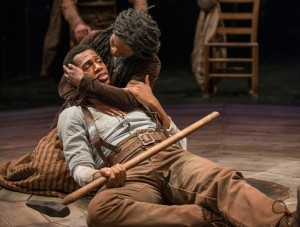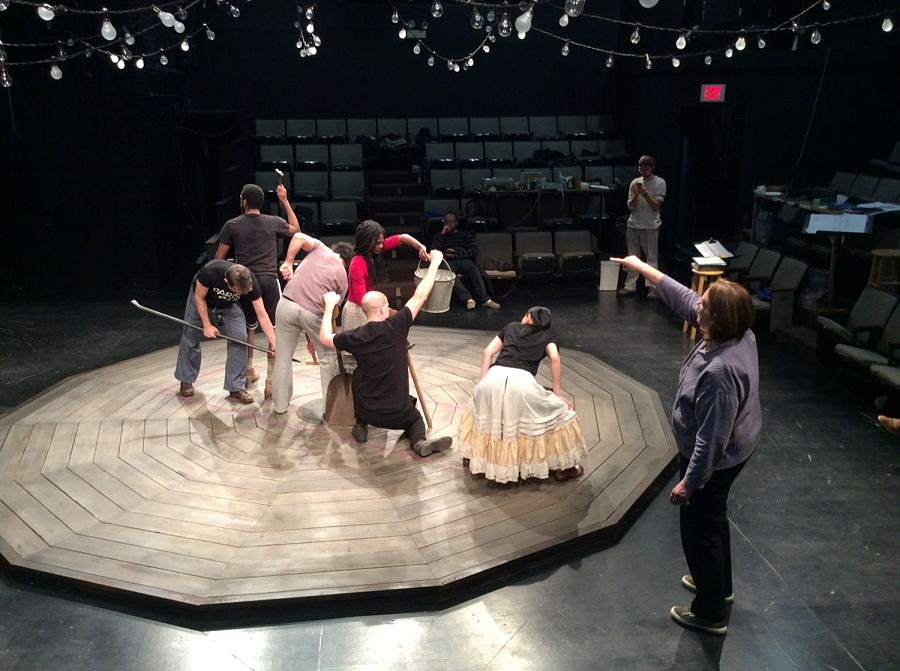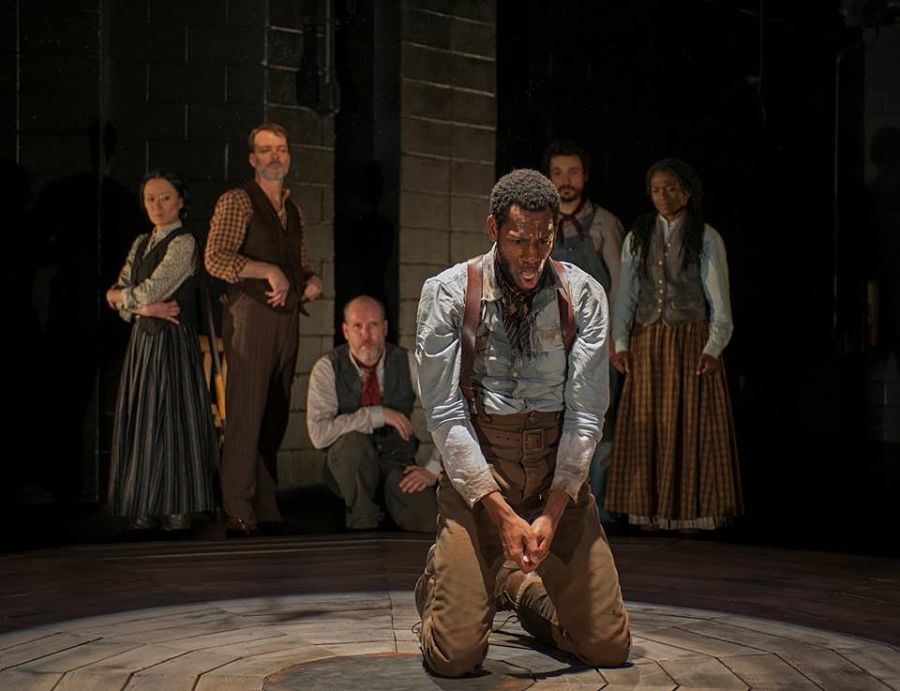There’s a moment in Steel Hammer, a collaboration between SITI Company and Bang On a Can All-Stars, when the protagonist, John Henry, dies. It’s roughly two thirds of the way through the performance, which runs Dec. 2–6 at the Brooklyn Academy of Music’s Next Wave Festival. And though we have seen the legendary folk figure, played by Eric Berryman, die before in the show, this time we wonder: Will he get up again?
Indeed, Henry has died onstage at least twice before, only to be resurrected again. This time is different. Berryman as Henry has just completed an eight-and-a-half-minute run, a kind of physical crescendo. Right before his fall at the performance I saw, I heard an audience member whisper to her neighbor, “How is he still going?” Just at the point in the story where Henry is exhausted and ready to give in, so too is Berryman. In this moment, the lines between character and performer blur.
“I’ve been beaten up, worked myself to death, I fall,” Berryman later told me. But then the ensemble gathers around him, he said, and helps him up. “They check in with me—the actor, not the character—to see if I can go on. I nod. They help me up. We lock arms. We dance. They help me beat the machine.”
The battle with the machine isn’t over yet. Stephen Duff Weber delivers a brief explanation of “the stint” to the audience: “Workers managed their labor by setting a stint, or pace ,” he says. “Here was a song that told you what happened to men who worked too fast: They died ugly deaths; their entrails fell to the ground. You sang the song slowly, you worked slowly, you guarded your life, or you died.”
At this the ensemble members lock arms. They line up, tallest to shortest, to create a diagonal line from downstage right to upstage left. The Bang On a Can All-Stars band plays the opening notes of “The Race,” a sharp, angular, metallic piece of music.
“We stomp and clap,” Berryman said. “We break apart as the machine tries to conk out, then we come back together again. Alone, we’re just cogs in the machine; together, we embody the machine.”
The image of the ensemble as a community is telling. Steel Hammer director Anne Bogart believes that each time an ensemble takes the stage, they are attempting a new way of life.
“By its nature the subject of the theatre is social systems: how people and communities do or do not get along,” Bogart said. “A play generally begins when something in the community goes awry. The drama results from a group’s shared search for restored equilibrium from a state of social instability. Oedipus kills his father and sleeps with his mother, causing havoc in the house of Atreus. Romeo and Juliet bear the brunt of their respective family’s feuds. Linda Loman tries desperately to hold her husband and disintegrating family together. Hamm, Clove, Nag, and Nell try to go on living together in what seems to be a post-apocalyptic, depopulated world. From a state of imbalance, a group of individuals attempt to reestablish stability.”
Composer Julia Wolfe, who wrote Steel Hammer as a concert piece for amplified ensemble and singers, began her process by listening to an extended community of musicians.
“I became fascinated by the fact that there were so many versions of the John Henry ballad,” Wolfe said. “All with different ‘facts’. I listened to versions by Furry Lewis and Mississippi Fred McDowell, to Woody Guthrie and Bruce Springsteen, and on and on.
Listening to so many different versions of the myth compelled Wolfe to compose songs like “Characteristics,” in which the contradictions abound.
“Regardless of whether they were true or not, this was what folks said about him,” Wolfe said. “He was a convict, he was a singer, he picked cotton, and so on. I wanted the list to be continuous, almost like a tongue twister, so that the information keeps coming at you and becomes a whirl of image and information.”
Bogart invited four playwrights to write the 10-minute plays that would become the libretto for the performance. Playwright Kia Corthron’s text takes the form of a tent show where John Henry is the subject. It doesn’t take long for the characters in Corthron’s text to begin noting the contradictions in various versions of the Henry myth. Then Henry begins to tell his own story.
“Elizabeth City, New Jersey-born,” Henry says. “But come down to Virginia I’m a prisoner. Convict, what am I guilty of?”
Though it’s never made clear what crimes Henry committed, each of the four Steel Hammer playwrights start with the assumption that he was a prisoner sentenced to hard labor. This refracted approach mirrors the processes employed by Bogart, Wolfe, and company.
“I was most taken with the contrast between Henry as hero and victim,” Corthron said. “I watched the Disney version of the story. I listened to Bruce Springsteen. But the blues artists had something else to say: They understood Henry’s pain; they knew that something else was going on.”
In Carl Hancock Rux’s text, Migrant Mamie Remembers John Henry, the title woman recalls a momentous chance meeting.
“John Henry is a story of man against machine during the industrial age,” Hancock Rux said. “It is also a story where history and imagination intersect in order to speak to the radical transformation of America at the dawn of the industrial age, and the often undocumented contribution of African-American laborers, enslaved and free, to the making of America. It puts a question mark at the end of the word ‘freedom’ and posits a heroic tale of human endurance as much as it tells a tragic tale of forced labor practices.”
Likewise, Regina Taylor’s text, which envisions multiple John Henrys toiling away in the dark tunnel where so many died, focuses on the gritty reality of the work.
“If there was a real John Henry,” Taylor said, “he would have died like so many miners, breaking rocks and inhaling the dust. They had no rights; they had no way out.”
When asked about the portrayal of Henry as a superhuman worker driven to defeat the steam drill by pride, Taylor paused.
“It certainly represents determination and will power,” Taylor said. “But I think he was trying to break free by winning that contest. He’s trying to blast his way to freedom. He achieves it only through death. That’s the tragedy of Henry’s situation.”
In Will Power’s text, the incarcerated Henry is visited by his wife, Polly Ann. Henry sums up his situation with uncanny omniscience: “Polly, why you waitin’ on me? You know I ain’t gettin’ outta here. First they say, when you work our fields, then we’ll let you out of here. Then they say, when you build our railroads, then, and only then, will we let you out. Then they said, when you fight our wars, no no, when you buy our drugs, no no no, when you work with us on this drug war thing, you play your part, then we promise you, John Henry, you’ll be released . . . I’m in here forever.”
Polly Ann falls silent for a moment, the weight of these words sinking in.
“Will you tell the children about me?” Henry asks.

“Of course,” replies Polly Ann. “And I won’t say nothing about prison, I won’t say nothing about that. And I’ll make you 6 foot 5 instead of 5 foot 2. And I’ll make up something about you beatin’ a steam engine . . . And you died a hero. How does that sound?”
“It sounds just fine,” Henry replies.
It’s a heartbreaking moment, wherein love, family, and a man’s spirit die at the hands of an absurd, relentless oppression, and a human being—embodied onstage by Patrice Johnson Chevannes—takes control of her own destiny.
“The audience is also seeing, simultaneously, how the community of actors is getting along,” Bogart said. “They’re seeing what kind of community the artists have created together in the rehearsal process. All of this is palpable and real and in the room. It is in the heat of a shared experience that an audience becomes its own society. You are here with a whole lot of other people. Can you handle that?”
Without the audience, Polly Ann’s triumph, which is every bit as heroic as Henry’s, would go unnoticed. In the face of soul-crushing defeat, Polly Ann creates a story that gives strength to others. She refuses to fall silent; she owns her story. Perhaps it was decisive moments like these that fueled all those famous ballads.

“Ballads were the social media of that time,” Berryman said. “So many of those young men died nameless. There were countless women writing letters at the time, searching for brothers, husbands, and sons. What these women didn’t know was that their loved ones were picked up, incarcerated, and sentenced to hard labor. Many were worked to death. They died nameless. But the John Henry ‘tweet’ made it through.”
In this way, the John Henry myth acts as a link to the past; the texts and music used to construct this performance become a bridge. On the other side of the bridge, the performers build the future. With each word spoken or sung, with each note played, with each stomp, clap, and gesture, they’re stepping into the future. They beckon the audience to follow.
“The theatre is ultimately about community,” Bogart added. “We are a community of people dealing with each other, challenging each other. The theatre is about social systems and how individuals in communities function in concert. Can the planet be shared or does it just belong to me?”
Indeed, though Henry is at the center of the story, the text itself is open, and the performance embodies a radical plurality.
“I can’t imagine John Henry as a one-man show,” Berryman said. “We’re all wrestling with our own machines, be they financial, emotional, or spiritual. Whether in the theatre or in life, it takes a community to beat them. The ensemble is a community. Every time I fall, they lift me up again. I feel that love, that support. That’s what it’s about. It’s amazing.”
David Dudley is a playwright/ journalist. He’s currently pursuing an MFA in playwriting from Southern Illinois University at Carbondale. His plays have been performed in New York, Chicago, Boston, California, Vermont, and Arizona.


